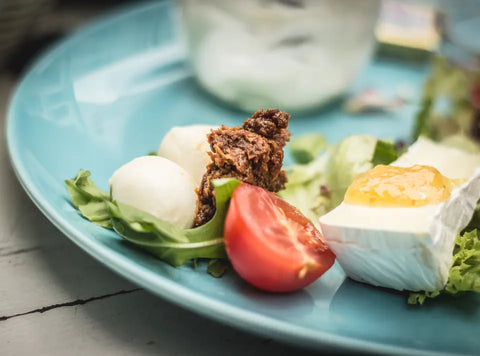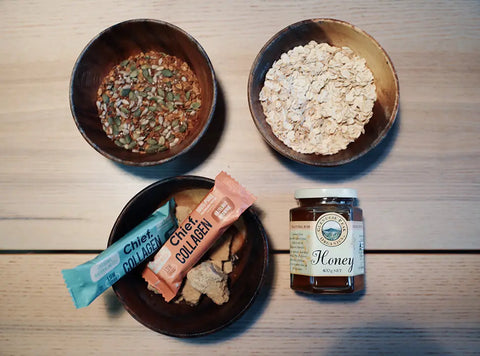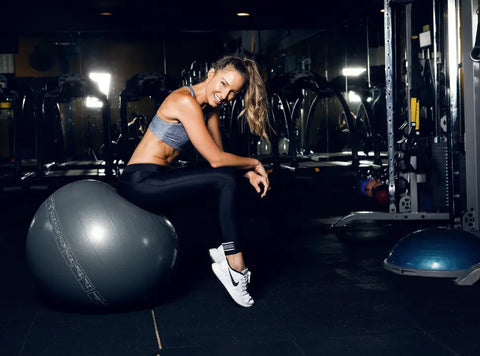The Ketogenic Diet (or Keto for short), is a diet very low in carbohydrate, high in fat and low to moderate in protein. The reduction in carbohydrate intake puts your body in a metabolic state called ketosis where your body uses ketones as an alternative source of energy instead of glucose.
When we eat very few carbs or very few calories, ketones are produced by the liver from fat. The ketones are then used as a fuel throughout the body, especially for the brain, which can’t utilise fat directly and can only run or glucose or ketones. This is the reason why the ketogenic diet has been used to successfully treat childhood epilepsy since 1920’s.
In a nutshell, when you are on a ketogenic diet, your body’s main fuel supply is fat instead of glucose. That’s what being ‘fat adapted’ means.
The best way to induce ketosis is fasting or creating a ‘ketogenic ratio’ of 4-parts fat to 1-part protein and carbohydrate, which equates to around 80% of calories in the diet from fat. The protein recommendation is 1.2-3g of protein per each kilogram of bodyweight per day and the rest of your daily calorie allowance is from carbohydrates.
At 60kg and 2000 kcal per day the exact macros would be
- Fat: 1600 kcal (178g)
- Protein: 288 kcal (72g)
- Carbohydrate: 112 kcal (28g)
This can be quite difficult to maintain and you can actually achieve great results by trying a modified ketogenic diet with 60-75% of calories from fat if you use MCTs (Medium Chain Triglycerides). That way you can have more carbohydrates and protein.
Benefits of a Ketogenic Diet
- Steady supply of energy instead of sugar highs and lows, which happens on a high carb diet and causes energy slumps and cravings. You are less hungry and more focused throughout the day when in ketosis.
- Low insulin levels (due to low blood glucose), which makes it easier for the body to access fat stores and burn them off. You still need to be in calorie deficit to lose weight though.
- Clinical application in treatment of various conditions such as epilepsy, neurogenerative disorders, obesity and metabolic syndrome, diabetes, cancer and autism.
What to eat on Keto and how to calculate Net Carbs?
The most important thing in reaching the state of ketosis (and staying in) is not having too many carbs. You’ll likely need to keep carb intake under 50 grams of net carbs per day, ideally below 20 grams. If you give your body carbs, your insulin will go up and your body will use blood glucose instead of fat.
In Australia it's pretty easy to simply follow the Carbohydrates figure shown in the nutrition information panel. However, when checking the carb content for US / Canadian labels, you should subtract Dietary Fibre from Carbohydrates to get Net Carbs (Total Carbs minus Fibre = Net Carbs). Fibre is a type of carbohydrate that your body can’t digest which means it does not affect our blood sugar levels so it's fine to work off Net Carbs.
The second important thing is choosing healthy foods. Sure, you can ingest lots of fat and little carbs by eating highly processed sausages and bacon but this kind of diet will not only rob you of essential nutrients necessary for your health and performance, it’s also inflammatory and potentially carcinogenic.
Top ten healthy foods to eat
- Low carb vegetables: you can use them to replace your starchy faves by making cauliflower rice or zucchini pasta. Although not as nutritious as organ meats, vegetables are a great source of vitamins, minerals and fibre.
- Seafood: have a good variety and lots of fatty fish such as salmon, sardines and mackerel. Go for wild caught.
- Meat and poultry: especially organ meat. Just 100g of organic liver contain about 50% of your daily vitamin and mineral requirement. Always choose grass fed, and organic if available.
- Avocados: they have a very low net carb count and very high potassium and fat content.
- Eggs: eggs are the perfect keto food as they have less than 1g carbs and 6g of protein. The yolks are packed with nutrients including antioxidants
- Fats: use olive oil for cold dishes and coconut oil, beef tallow or butter for cooking and baking. Coconut contains MCTs, which are converted to ketones more rapidly than other fats.
- Nuts and seeds: they are high in fat and fibre and low in carbs. You can use them for a snack or to give your salad a crunch. The best is that you can use any nut meal (ground nuts) to replace flour in baking. Zucchini bread made from zucchini, almond meal, eggs and olive oil is totally keto and tastes delicious. So you don’t have to give up your smashed avo.
- Berries: they are low in carbs and high in fibre and antioxidants. The perfect keto sweet treat. Especially when you put them into your coconut yoghurt or blend with coconut cream. Yum!
- Konjac noodles: these noodles have almost no calories and virtually no carbs, making them perfect for the keto diet. How about chicken bone broth with konjac noodles?
- Dark chocolate and cocoa powder: it has to be high in cocoa to be suitable for keto. 100% cocoa is the best but you can start with 80% to get used to it. It has lost of good stuff in it such as antioxidants. It’s only healthy in small amounts as an occasional treat.
A simple Keto meal plan example
Breakfast- Cup of long black coffee
- Toasted zucchini bread smashed avocado
- Green bowl with two eggs and nuts
- Seafood zoodles
- Coconut yoghurt with berries
- Handful of nuts
- Sashimi
- Chief Bar
Chief Collagen bars are the perfect keto treat with an added benefit of collagen.
A simple Keto bread recipe
Zucchini Keto Bread
From fastleanenergy.com
What you'll need
- 450g grated raw zucchini
- 4 whole organic eggs
- ½ tsp Himalayan pink salt
- ¼ cup melted coconut oil
- ¾ tsp baking soda
- 1 tbsp fresh lemon juice
- 300g almond meal (you can also use hazelnut meal or any nut meal you like; you can also use 150g lupin flour for even lower carb)
- 150g Green olives stuffed with red capsicums
- Fresh Thai basil
- Fresh dill
- Sunflower seeds to sprinkle on top
- Preheat oven to 180 C (or 150-160 Fan forced)
- Squeeze water from the zucchini
- Mix zucchini, eggs, salt, lemon juice, shredded herbs, chopped up olives and oil in a bowl
- Add almond meal and baking powder and mix well
- Line a loaf tin with baking paper (base and sides)
- Spoon the mixture into the tin, press and sprinkle with seeds
- Bake for 1.5 hrs (check after 1 hour as every oven is different)
- Remove from the oven, rest for one hour in the tin then remove
- Cool and save in airtight container in the fridge for up to 6 days and freeze the rest
TIP: Tastes delicious with avocado or nut butter. You can also use it instead of a regular bread and put some eggs on it for breakfast. If you like dairy you can top with ricotta or quark. Be creative ;)





Comments (0)
There are no comments for this article. Be the first one to leave a message!